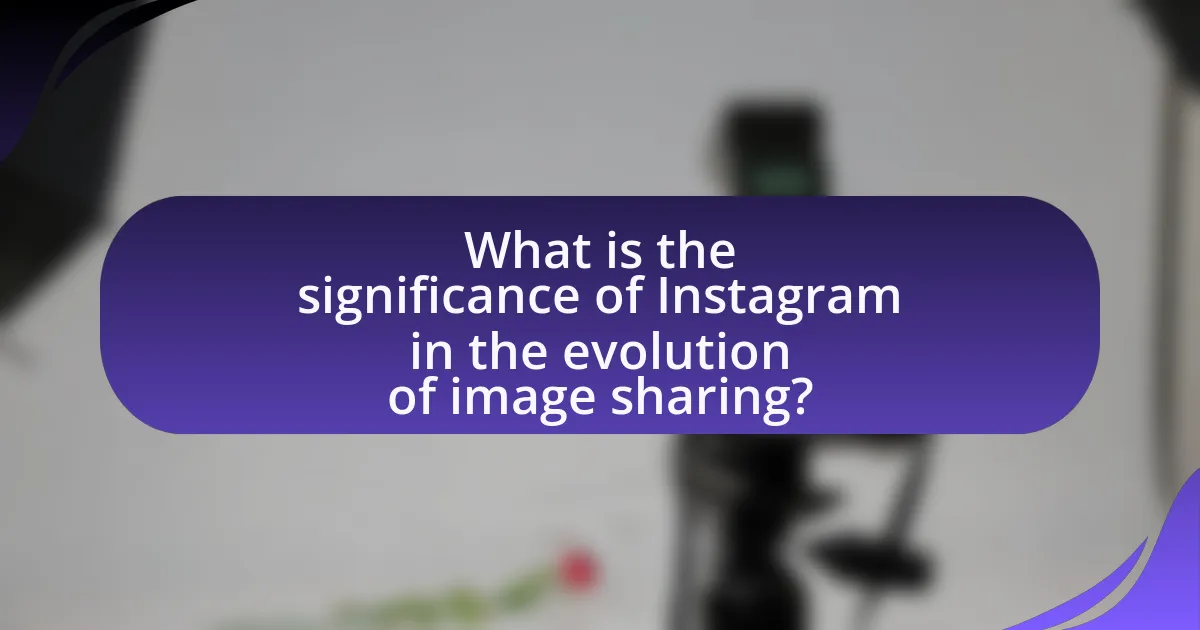Image sharing platforms are online services that enable users to upload, share, and manage images, significantly influencing digital communication and marketing strategies. This article examines the evolution of these platforms, highlighting key milestones from the launch of Flickr in 2004 to the rise of Instagram in 2010, which transformed image sharing through mobile-first design and social interaction. It explores how user needs have shaped platform features, the distinct roles of Flickr and Instagram, and current trends such as ephemeral content and augmented reality. Additionally, the article addresses the impact of emerging technologies and privacy concerns on user behavior and platform functionalities, providing best practices for effective image sharing.
What are Image Sharing Platforms?

Image sharing platforms are online services that allow users to upload, share, and manage images. These platforms facilitate the distribution of visual content, enabling users to showcase their photography, artwork, or personal moments to a broader audience. Popular examples include Flickr, which launched in 2004 and became a significant player in the early days of online photo sharing, and Instagram, which was introduced in 2010 and revolutionized image sharing with its mobile-first approach and social networking features. The growth of these platforms has transformed how individuals and businesses engage with visual media, making it an integral part of digital communication and marketing strategies.
How have image sharing platforms evolved over time?
Image sharing platforms have evolved significantly from early sites like Flickr to modern applications such as Instagram. Initially, platforms focused on simple photo uploads and community engagement, allowing users to share images with limited social interaction. Flickr, launched in 2004, pioneered user-generated content and community features, enabling tagging and groups for photo sharing.
As technology advanced, mobile accessibility and social networking became paramount. Instagram, launched in 2010, transformed image sharing by emphasizing mobile-first design, filters, and instant sharing capabilities, which catered to a growing user base seeking visual storytelling. The integration of features like Stories and Reels further enhanced user engagement and content creation.
The evolution also reflects changes in user behavior, with a shift towards visual-centric communication, driven by the rise of smartphones and social media. According to a report by Statista, as of 2021, Instagram had over 1 billion monthly active users, highlighting its dominance in the image sharing space compared to earlier platforms. This trajectory illustrates how image sharing platforms have adapted to technological advancements and user preferences over time.
What were the key milestones in the development of image sharing platforms?
The key milestones in the development of image sharing platforms include the launch of Flickr in 2004, which popularized user-generated photo sharing and tagging. In 2005, the introduction of Photobucket allowed users to upload and share images easily, further expanding the concept of online photo sharing. The emergence of social media platforms like Facebook in 2006 integrated image sharing into social networking, significantly increasing user engagement with photos. Instagram’s launch in 2010 revolutionized mobile photo sharing with its focus on filters and social interaction, leading to its acquisition by Facebook in 2012 for approximately $1 billion, solidifying its status in the market. These milestones collectively illustrate the evolution of image sharing from standalone platforms to integrated social experiences.
How did user needs influence the evolution of these platforms?
User needs significantly influenced the evolution of image sharing platforms by driving the development of features that enhance user experience and engagement. For instance, Flickr initially catered to photography enthusiasts by offering advanced organizational tools and community features, which reflected the need for a platform that supported high-quality image sharing and social interaction among photographers. As user preferences shifted towards mobile accessibility and instant sharing, Instagram emerged, prioritizing simplicity and immediacy, thus addressing the demand for quick, visually appealing content sharing. This transition highlights how platforms adapt to changing user expectations, such as the desire for mobile-friendly interfaces and social connectivity, ultimately shaping their functionalities and design.
What role did Flickr play in the early days of image sharing?
Flickr was a pioneering platform in the early days of image sharing, significantly influencing how users uploaded, organized, and shared photos online. Launched in 2004, it introduced features such as tagging, photo sets, and social networking elements that allowed users to connect through shared interests. Flickr’s user-friendly interface and community-driven approach facilitated the growth of online photography communities, making it a vital resource for amateur and professional photographers alike. The platform’s emphasis on user-generated content and its integration with Creative Commons licensing further established it as a key player in the democratization of image sharing, allowing for broader distribution and use of photographs.
What features made Flickr popular among users?
Flickr became popular among users primarily due to its robust community features, extensive storage options, and advanced organizational tools. The platform allowed users to upload and share large quantities of photos, with a free account offering 1,000 photos and a pro account providing unlimited storage. Additionally, Flickr’s tagging system enabled users to categorize and search for images easily, enhancing discoverability. The social networking aspect, including the ability to comment on and favorite photos, fostered engagement and interaction among users. These features collectively contributed to Flickr’s appeal as a comprehensive photo-sharing platform.
How did Flickr’s community aspect contribute to its success?
Flickr’s community aspect significantly contributed to its success by fostering user engagement and collaboration through features like groups, comments, and tagging. These elements allowed users to connect over shared interests, enhancing the platform’s social experience. For instance, the ability to join groups based on specific photography styles or themes encouraged users to share their work and receive feedback, which in turn increased user retention and content generation. Additionally, the tagging system facilitated easier discovery of images, promoting interaction among users and expanding the platform’s reach. This community-driven approach not only attracted a diverse user base but also established Flickr as a leading platform for photographers and enthusiasts, ultimately solidifying its position in the image-sharing landscape.
What is the significance of Instagram in the evolution of image sharing?

Instagram is significant in the evolution of image sharing because it revolutionized how users create, share, and engage with visual content. Launched in 2010, Instagram introduced features such as filters and a user-friendly interface that encouraged spontaneous sharing of high-quality images. By 2021, Instagram had over 1 billion monthly active users, demonstrating its widespread adoption and influence. The platform’s focus on visual storytelling and community engagement has shifted the landscape from traditional photo-sharing sites like Flickr, which emphasized organization and archiving, to a more dynamic, interactive experience. This transformation has made Instagram a central hub for influencers, brands, and everyday users to connect through imagery, fundamentally changing the way images are consumed and shared online.
How did Instagram change the landscape of image sharing platforms?
Instagram revolutionized the landscape of image sharing platforms by introducing a mobile-first approach that prioritized user-generated content and social interaction. Launched in 2010, Instagram’s focus on visually appealing, square-format images and a user-friendly interface encouraged millions to share their photos instantly. The platform’s integration of features like filters, hashtags, and stories enhanced user engagement and creativity, setting a new standard for visual storytelling. By 2021, Instagram had over 1 billion monthly active users, demonstrating its significant impact on how individuals and brands share and consume visual content online.
What unique features did Instagram introduce that set it apart from Flickr?
Instagram introduced unique features such as a mobile-first design, real-time photo sharing, and an emphasis on social interaction through likes and comments, which set it apart from Flickr. The mobile-first design allowed users to capture and upload photos instantly from their smartphones, catering to the growing trend of mobile photography. Real-time sharing enabled users to post images immediately, fostering a sense of immediacy and connection. Additionally, Instagram’s focus on social engagement through likes and comments created a more interactive community, contrasting with Flickr’s more static and portfolio-oriented approach. These features contributed to Instagram’s rapid growth and popularity among users seeking a dynamic and engaging photo-sharing experience.
How did Instagram’s mobile-first approach impact user engagement?
Instagram’s mobile-first approach significantly enhanced user engagement by prioritizing a seamless mobile experience that encouraged frequent interaction. This strategy led to a user base that was more active, as evidenced by statistics showing that Instagram users spend an average of 30 minutes per day on the app, with over 500 million daily active users engaging with Stories alone. The focus on mobile accessibility allowed users to easily capture and share moments in real-time, fostering a culture of immediacy and spontaneity that kept users returning to the platform.
What are the key differences between Flickr and Instagram?
Flickr and Instagram differ primarily in their focus and functionality. Flickr is designed for photographers and emphasizes high-quality image storage and organization, allowing users to upload and categorize photos into albums, while Instagram prioritizes social interaction and mobile sharing, featuring a feed where users can post images and engage with others through likes and comments.
Flickr offers extensive metadata options, including tags and descriptions, which enhance searchability and organization, catering to a community of professional and amateur photographers. In contrast, Instagram’s interface is streamlined for quick sharing and visual storytelling, with features like Stories and Reels that encourage ephemeral content and immediate engagement.
Additionally, Flickr allows for larger file uploads and offers a pro subscription for additional storage, while Instagram compresses images for faster loading times and focuses on a mobile-first experience. These distinctions highlight how each platform serves different user needs within the realm of image sharing.
How do the user demographics of Flickr and Instagram compare?
Flickr and Instagram have distinct user demographics, with Flickr primarily attracting older users and photography enthusiasts, while Instagram appeals to a younger audience, particularly millennials and Gen Z. According to a 2021 survey, approximately 60% of Flickr users are aged 35 and older, whereas over 70% of Instagram users are under 35. This demographic difference highlights Flickr’s focus on professional and hobbyist photographers, contrasting with Instagram’s emphasis on casual sharing and social interaction among younger users.
What types of content are most commonly shared on each platform?
The types of content most commonly shared on image-sharing platforms vary by platform. On Instagram, visually appealing images, lifestyle content, and short videos dominate, with a focus on aesthetics and engagement. Facebook primarily features personal updates, news articles, and shared videos, catering to a broader audience with diverse interests. Twitter is known for real-time updates, memes, and news snippets, emphasizing brevity and immediacy. Pinterest focuses on curated images related to DIY, fashion, and home decor, serving as a visual discovery tool. Each platform’s content type reflects its user base and intended purpose, influencing sharing behaviors.
What are the current trends in image sharing platforms?

Current trends in image sharing platforms include the rise of ephemeral content, increased integration of augmented reality (AR) features, and a focus on community-driven engagement. Ephemeral content, such as Stories on Instagram and Snapchat, has gained popularity, with over 500 million users engaging with Instagram Stories daily. The integration of AR features allows users to enhance their images with interactive elements, as seen in platforms like Instagram and Snapchat, which have invested heavily in AR technology. Additionally, community-driven engagement is emphasized through features like collaborative albums and group sharing, fostering a sense of belonging among users. These trends reflect the evolving landscape of image sharing, driven by user preferences for immediacy, interactivity, and community connection.
How are emerging technologies shaping the future of image sharing?
Emerging technologies are significantly shaping the future of image sharing by enhancing user experience through advanced features like artificial intelligence, augmented reality, and blockchain. Artificial intelligence algorithms improve image recognition and personalization, allowing platforms to curate content more effectively and tailor user feeds based on preferences. Augmented reality enables interactive image sharing experiences, allowing users to overlay digital elements onto real-world images, thus increasing engagement. Blockchain technology offers secure and transparent ownership verification, which can revolutionize how creators share and monetize their images, ensuring that artists receive fair compensation for their work. These technologies collectively drive innovation in image sharing, making it more dynamic, secure, and user-centric.
What role does artificial intelligence play in image sharing platforms today?
Artificial intelligence plays a crucial role in image sharing platforms today by enhancing user experience through personalized content recommendations, automated tagging, and image recognition. These platforms utilize AI algorithms to analyze user behavior and preferences, allowing them to suggest images that align with individual interests, thereby increasing engagement. For instance, Instagram employs machine learning to curate personalized feeds, ensuring users see content that resonates with them. Additionally, AI-driven image recognition technology enables automatic tagging of photos, streamlining the process of organizing and searching for images. This technology can identify objects, scenes, and even emotions within images, making it easier for users to find relevant content. The effectiveness of these AI applications is evidenced by increased user retention and interaction rates on platforms like Instagram and Pinterest, where tailored experiences significantly enhance user satisfaction.
How are privacy concerns influencing platform features and user behavior?
Privacy concerns are significantly influencing platform features and user behavior by prompting platforms to enhance data protection measures and users to adopt more cautious sharing practices. For instance, platforms like Instagram have implemented features such as enhanced privacy settings, allowing users to control who can view their content and interact with them. This shift is evidenced by a 2021 survey indicating that 81% of users feel they have little control over their data online, leading to increased demand for transparency and user-centric privacy controls. Consequently, users are more selective about the content they share and the platforms they engage with, prioritizing those that demonstrate a commitment to safeguarding their personal information.
What best practices should users follow when sharing images online?
Users should follow several best practices when sharing images online to ensure safety and respect for privacy. First, users should always consider the privacy settings of the platform they are using, as these settings can control who sees the images. For instance, platforms like Instagram allow users to set their accounts to private, limiting visibility to approved followers.
Second, users should avoid sharing sensitive or personal information within images, such as location tags or identifiable landmarks, which can compromise their safety. Research indicates that oversharing personal details can lead to risks such as stalking or identity theft.
Third, users should respect copyright laws by only sharing images they own or have permission to use, as unauthorized sharing can lead to legal consequences. According to the U.S. Copyright Office, using someone else’s work without permission is a violation of copyright law.
Lastly, users should be mindful of the content they share, ensuring it aligns with community guidelines to avoid potential bans or account suspensions. Many platforms have specific rules regarding hate speech, nudity, and harassment, which users must adhere to.
How can users effectively engage with their audience on image sharing platforms?
Users can effectively engage with their audience on image sharing platforms by consistently posting high-quality, relevant content that resonates with their target demographic. Engaging content encourages interaction, which can be measured through likes, comments, and shares. Additionally, utilizing features such as hashtags, geotags, and stories can enhance visibility and foster community engagement. Research indicates that posts with at least one hashtag receive 12.6% more engagement than those without, highlighting the importance of strategic tagging. Furthermore, responding to comments and messages promptly builds a sense of community and encourages ongoing interaction, reinforcing user loyalty and engagement.
What strategies can enhance the visibility of shared images?
To enhance the visibility of shared images, utilizing effective tagging and engaging with the audience are crucial strategies. Tagging images with relevant keywords increases discoverability on platforms like Instagram and Flickr, as users often search for specific tags. Engaging with the audience through comments, likes, and shares fosters community interaction, which can lead to increased visibility through algorithmic promotion. Additionally, posting during peak times when user activity is highest can significantly boost the chances of images being seen. Research indicates that posts made during optimal engagement hours receive up to 30% more interactions, further validating the importance of timing in image sharing.



